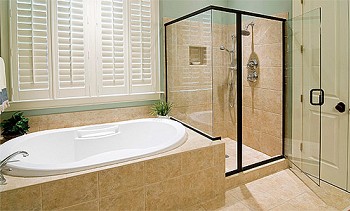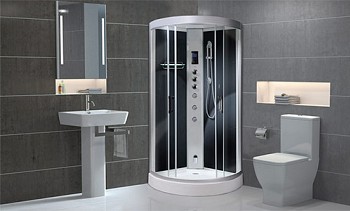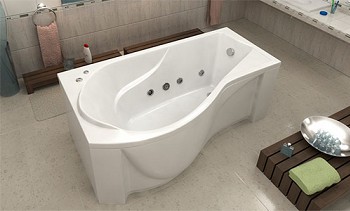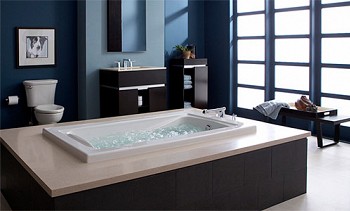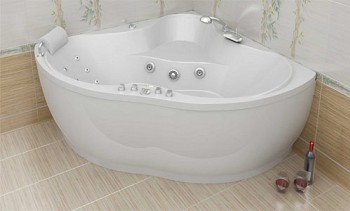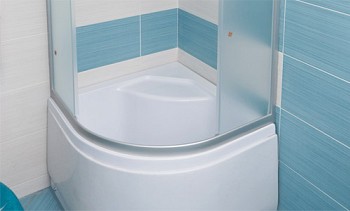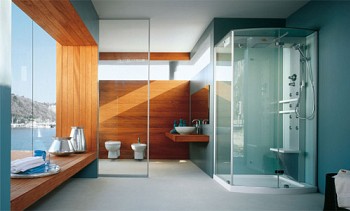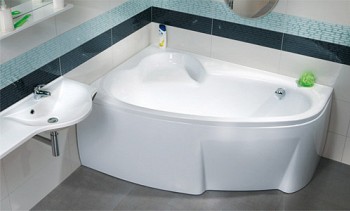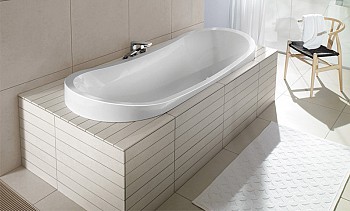A bath is a mandatory attribute and the main subject of plumbing in any bathroom. In this case, often, the bath performs the function of not only the subject of hygiene, but also serves to relax. Lying in a bowl with soapy water, with a small amount of various additives and oils, allows you to restore overall tone, make skin smoother or relieve stress after a difficult working week. In addition to the hygienic and health-improving functions, the bowl of the bathroom, due to its large dimensions, will certainly participate in the formation of the overall interior of the bathroom.
When wondering how to choose a bath, many users find themselves in a rather difficult situation. Indeed, in reality, sellers of plumbing stores offer their customers to buy a bathtub from a wide variety of materials, while plumbing models have a huge variation in size, volume and shape.
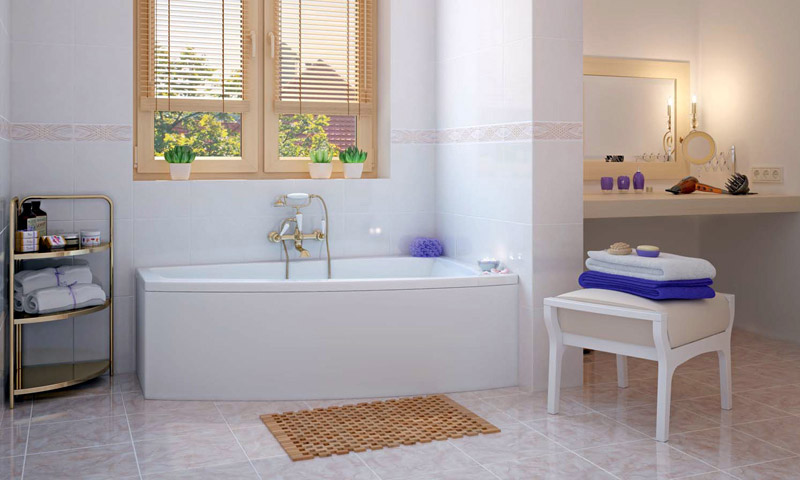
Content:
Choosing a bath material
Today you can buy a bath from the following materials:
- Cast iron;
- Steel;
- Acrylic;
- Cooked;
- Ceramics.
Cast-iron bathtubs - time-tested plumbing
As the name implies, cast-iron bathtubs are made of a metal grade such as cast iron by casting. Cast iron itself is an alloy of iron (Fe) with a high carbon content (C). To increase certain qualities of the alloy, silicon (SI), manganese (Mn) or sulfur (S) are additionally introduced into it. In general, cast iron is not plastic, not flexible, very durable grade of metal. One problem is that it is fragile, but this does not affect the quality of plumbing made of cast iron. For example, for reference, to break a cast-iron bath, you need a remarkable male physical strength and a heavy sledgehammer, weighing about 10 kg. In the course of normal household use, the maximum that can happen is a soap dish or a razor that is missing in the bowl of the bathroom.
However, the cast-iron bath owes its longevity not only to a strong metal alloy, but also a significant role is played by plumbing surface coverage. As a coating of a cast-iron bath, two-layer enamel is used. Rather, the enamel layer is one, but it is applied in the factory in several approaches. The first layer provides proper adhesion of the enamel to the metal, and the second layer is the front, that is, it provides the necessary smoothness of the surface. The duration of abrasion of the enamel coating of the cast-iron bath is from 10 to 30 years or more, it all depends on the intensity of operation.
If you correlate all the advantages and disadvantages of cast-iron bathtubs, then the conclusion is that this plumbing is ideal for installation on the ground floor of a country house. For a bathroom in an apartment that has a relatively small area, this plumbing will be too cumbersome, and its installation will be difficult. Although at present cast-iron bathtubs are installed in a large number of apartments still Soviet-built. You should also recall such a popular suburban housing, lightweight type. Installing a cast-iron bathtub on the second floor of a house of timber or frame housing is not desirable due to the large weight of the plumbing.


+ The benefits of cast iron bathtubs
- High structural strength and enamel layer;
- The water temperature remains for a long time;
- Unpretentious care of plumbing;
- No noise during water intake.

— The disadvantages of cast iron bathtubs
- Big weight, up to 150 kg;
- A very meager variety of sizes and shapes;
- The laborious process of restoring enamel in case of damage.
Steel bathtubs - a cheaper alternative to cast iron
Steel bathtubs are made of two types of steel:
- Structural;
- Stainless.
Structural steel bathtubs look very much like cast-iron fixtures. Their wall thickness can be from 2.5 to 4.5 mm, and acrylic enamel is used as a coating. On sale there are both bathtubs of a classical form in the form of an oval, and plumbing of the most bizarre configurations: with one or more seats, with various head restraints, shelves and bends. This is achieved thanks to the ductility and ductility of sheet steel, which cannot be said for cast iron.
Stainless steel bathtubs are less common in the domestic plumbing market, although if you look well, you can still buy a stainless steel bathtub. Low demand is mainly due to the high price. For example, a structural steel bath costs about 3-4 times cheaper than a cast-iron bath. Whereas a stainless steel bath can cost the other way around, 2 times more expensive than cast iron sanitary ware. The thing is that the stainless bathtub does not have an enamel coating, that is, the surface of the bowl is polished metal and, to extend the time of plumbing and to avoid the formation of corrosion or oxidation on its walls, manufacturers use directly stainless steel, the price of which leaves much to be desired.
The degree of deflection of the walls of the plumbing directly depends on the thickness of the metal and the load applied. When wondering how to choose a bath, first of all, it is necessary to take into account the complexion of the bodies of family members. For example, if a family has members who are overweight, then you should think about buying a steel bath, since the weight of the obese person and the weight of the water filled into it will affect the walls of the plumbing. All this can lead to deformation of the font walls. If the weight and composition of households are normal, then buying a steel bath with a wall thickness of 3 mm or more will be an excellent solution for both an apartment and a country house.

As for excess noise during the filling of water, this problem is solved in two ways:
Method 1

In the first case, Penofol (or analogues), sheet rubber or rubber are glued to the outer bottom of the plumbing. Plate thickness approx. 10 mm.
Method 2

In the second case, a shapeless layer of polyurethane foam is applied to the surface of the outer walls and the bottom of the bowl before installation, which, when hardened, will act as a sound insulator.

+ The benefits of steel bathtubs
- Low affordable price;
- Light weight construction;
- A wide variety of shapes and sizes;
- Durable wear-resistant enamel.

— Pronounced steel bath imperfections
- Able to bend;
- Filled warm water quickly cools;
- Creates noise during filling.
Acrylic bathtubs - extravaganza of design ideas in the world of plumbing
Acrylic bathtubs are “cheap” and “expensive”. It all depends on the technological method of production of plumbing and materials used. Acrylic itself is a type of elastic, strong and smooth plastic, however, in the plumbing shop you can buy an acrylic bath made from the following materials:
- Acrylonetrile Butadiene Styrene + Polymethyl Methacrylate;
- 100% polymethyl methacrylate.
Polymethylmethacrylate itself is a rather expensive material, however, it has high strength, low water absorption, and a glossy smooth surface. A bathtub made of pure PPMA with intensive use in a city apartment can live 12 years or more, however, the price for this plumbing will be 2-4 times higher than for bathtubs made according to a two-component scheme.
In acrylic bathtubs manufactured according to the ABS / PMMA scheme, the outer glossy layer of polymethylmethacrylate is only 5-10% of the total wall thickness. It is clear that such a thin layer in 3-5 years can easily wear out due to operation. After abrasion of the first layer, the lower layer of ABS begins to intensively absorb moisture, after which all the plumbing becomes unusable.The hygroscopicity of the ABS is not at all like a sponge, no, it’s just that the structure of this type of plastic is porous and, mainly, this material is intended for plumbing, but not as a front surface.
Acrylic bathtubs from famous manufacturers are of high quality. Their walls do not bend when the font is fully filled, and nothing happens with the acrylic coating itself even when using water with a temperature of 70 °. It turns out that if the choice was “acrylic”, then determining which bath to choose, the main criterion is the technological scheme of its manufacture. For example, if you need to install a bath in a city apartment, then it is better not to spare money and buy plumbing made from pure polymethyl methacrylate. If we are talking about installing a bathroom in the country or, in general, it is rarely planned to use it, then here you can save a little and buy an acrylic bathtub ABS / PMMA.


+ The benefits of acrylic bathtubs
- Minimum light weight plumbing;
- The average cooling time of warm water;
- A wide range of different shapes and sizes;
- A large number of models with additional features;
- Huge price range.

— The obvious disadvantages of acrylic bathtubs
- The walls of a poor-quality bath can sag greatly;
- Vulnerability of acrylic to heat;
- It is necessary to carefully choose detergents;
- The price of some space models.
Kvarilovye bathtubs - modified acrylic
More recently, in the Russian market of sanitary ware, bathtubs from Quaril appeared. Basically, all the sanitary ware from quartz is represented by the products of the German company Villeroy & Boch AG, which is the legitimate developer of new material and technology. The material quaril in composition consists of acrylic and fine quartz sand. Upon hardening of such a composition, a structure is obtained when each quartz grain of sand is enclosed in an acrylic shell, and each grain of sand is connected to a neighboring similar particle. In practice, the material turned out to be visually and in its smoothness very similar to acrylic, but the quartz is superior to acrylic in strength and wear resistance.
The wall thickness of the bath of quaril is about 9-10 mm, while if the plumbing made of acrylic must be reinforced with several layers of fiberglass impregnated with polymer from the outside, then the bath tubs do not have such a reinforcement. Another feature of a quartz bathtub is the ability to purchase and operate a model that does not require a power metal frame to be installed. There are a huge number of models of bathtubs that are visually similar to cast-iron bathtubs, and which are installed on legs. A familiar classic created from modern materials. Among the shortcomings of the quartz bathtubs, one can distinguish their relatively large weight compared to acrylic sanitary ware, and high cost.


+ Advantages of Kvarilny baths
- The walls do not bend when the cup is full;
- Scratch and slight impact resistant surface;
- Can be installed without power frame;
- There are models with the correct geometry of angles;
- A huge number of shapes and sizes;
- Long service life.

— Disadvantages of plumbing
- Relatively high weight;
- High cost of production.
Ceramic bathtubs - the choice of true aesthetes
Ceramic bathtubs, according to the manufacturing method and materials, are divided into earthenware and metal-ceramic. At cost, earthenware plumbing is the most expensive. It is made from Fanirton - fireclay faience, that is, noble varieties of white clay. Fanirton itself, even after high-temperature firing, is a very hygroscopic material with water absorption of up to 16%. For this reason, after the formation of the bowl of the font and the passage of its temperature hardening, a layer of acrylic glaze is applied to the surface of the chamotte faience.
Ceramic-metal baths differ significantly in manufacturing method and cost.During their production, the metal frame is initially assembled - the base, which is subsequently enveloped with alumina and subjected to high-temperature firing, followed by glazing. The main difference between cermets and pure ceramics is the smaller wall thickness of the font and much less weight. The price for cermets is lower than for pure ceramics. This is mainly due to the lower consumption of expensive white clay.
As for models of ceramic bathtubs, bathtubs with classic oval shapes are most often found on the Russian plumbing market. Color can be white, blue, turquoise, beige, and even coffee. Ceramic bathtubs with unusual shapes in the form of a round saucer, with the correct geometric angles or with a font in the form of a figure eight appear much less often on sale.


+ Advantages of ceramic bathtubs
- Flawless glossy smooth surface;
- A wide range of colors of glaze;
- A wide variety of shapes and patterns;
- Duration of maintaining water temperature;
- No noise during filling;
- Durability with careful use.

— The disadvantages of ceramic bathtubs
- Heavy weight;
- Location to chips and cracks;
- High price of products.
How to choose a bathtub of optimal size
Having stopped the choice on a certain material and color scale, pass to the choice of the optimum size of bathroom equipment.
In this case, four main parameters should be taken into account:
- The height of the side above the floor;
- Bowl depth;
- Bowl length;
- The width of the bowl.

The height of the plumbing is determined based on the average height of family members and also takes into account whether there are children among households. For an adult, 65-70 cm is considered the optimal height. However, if the family has small children, it is better to choose a lower bath.
The depth of the bowl is the distance from the bottom of the font to the top edge of the side or overflow siphon. When determining the depth, it is important to take into account the moment that, when filled, water should completely cover the lying person. On average, 50-60 cm is considered the optimal depth.
The length and width of the bathroom are selected based on the individual characteristics of family members. The average font length is 150-180 cm, and the width is 70-80 cm, however, these data are calculated for a person who is 170-180 cm tall and not inclined to fullness.
The position of the human body, depending on the size of the bath.

Now let's talk about the sizes of bathtubs from specific materials.
1. Cast-iron bathtubs are presented on the Russian market in two categories: miniature 70 by 120 cm, sometimes miniature sanitary ware with a length of 130 cm appears on sale; and bathtubs of the Eurostandard category, with a length of 140-150 cm and a width of 70 cm. As you can see, cast-iron bathtubs are very limited in the variety of dimensions of the bowl.
2. Steel bathtubs are made with a bowl length of 150-180 cm, and a width of 70-85 cm. Sometimes there are bathtubs made of steel of the "economy" class. Here, it is more likely to save not money, but space in the bathroom, since the font length can be as little as 120 cm.
3. Acrylic bathtubs before the consumer reveal the most wide possibilities. On sale you can find models with a long bowl of 120-190 cm, and a width of 70-170 cm. Much depends on the shape and general configuration.
4. Ceramic bathtubs with a classic oval bowl most often have dimensions: length 130-170 cm and width 65-75 cm. Again, much depends on the configuration of the plumbing.
What form is best to choose a bath, and what type of installation
Determining the form of plumbing, first of all, you need to choose the type of bath.
By the type of installation in the bath room there are:

Wall

Angular
Wall-mounted baths can be installed close to the side of one of the walls, or in general, can be removed from the walls in the room. Corner, as the name implies, is installed in one of the corners of the bathroom. Therefore, the type of plumbing depends on its possible form.
Wall type has more different variations of forms. The most popular shape, of course, is an oval, but there are models with the shape of an ellipse, circle, figure eight or with asymmetric curved lines.Corner baths are most often found with the shape of a quarter circle with the correct geometry. Angular fonts with an asymmetric, intentionally irregular shape are less common.

Symmetrical corner bath.

An example of an angular asymmetric bath, it can be either left-handed or right-handed.

Round bowl of bath.
When choosing a bathtub for a city apartment, it is important to consider the available area of the bathroom. The area of the room, the minimum set of furniture that will be located in the bathroom and, possibly, installed household appliances, for example, a washing machine, are taken into account. From the area that remained after the calculations, should already be repelled in the choice of installation type and shape of the bath.
Additional features of the bathtubs and the appropriateness of their use
From what material the bathtub is selected from, the presence of additional functions in its design may directly depend.
- Cast iron or steel tub - additional options, most often absent.
- Acrylic or quaril bath - depending on the model, hydromassage, air massage, chromotherapy, an empty bath disinfection system and a water level sensor can be built in.
Hydromassage

Hydromassage is realized due to the operation of a special installed pump, which pumps water into the nozzles provided in the walls of the font. As a result, the effect of the flow of water is produced in the filled bath. This favorably affects the human body; relaxation and improvement of tone are performed.
Air massage

Air massage, like hydromassage, is made thanks to the work of a low-power electric pump. The only exception is that from the nozzles located on the walls of the bath, not a stream of water is supplied, but oxygen bubbles. Often plumbing, which combines both air massage and hydromassage, is called in one word - a jacuzzi.
Chromotherapy

Chromotherapy is a system designed to increase overall tonus, improve blood vessel function and affect a person’s body with a weak antibacterial effect. The principle of chromotherapy is the work of purple lamps in special reflectors during the adoption of water procedures. The “blue lamps” built into the walls of the font illuminate the body of a lying person from all sides.
The auto-disinfection system is an additional option, which, after taking a bath and draining the water, delivers a disinfectant to the font walls through special openings, which the system automatically rinses off later.
Water level sensor - in principle, an adult does not need it. The main task of the sensor is to determine how full the bowl of the bathtub is, since, for example, if you turn on the hydromassage or air massage with an empty font, the main pump and all systems can quickly fail. The water level sensor, in turn, simply does not turn on the hydromassage with an empty bowl.
How to choose bath manufacturers
1. If we talk about cast-iron bathtubs, then on the domestic plumbing market one can distinguish the three largest sellers: Russian products of the Universal plant, Spanish products under the Roca trademark, and products of the French company Jacob Delafon.
2. Steel baths are represented on the domestic market by Russian manufacturers: Verkh-Isetskiy Metallurgical Plant and Lipetsk Pipe Plant. Of the foreign plumbing sellers, the following stand out: Roca - Spain, Bette - Germany, BLB - Portugal, and Estap - Slovakia.
3. Acrylic bathtubs are imported into Russia from almost all European countries, as well as from Turkey and China. The most notable manufacturers are: Ravak - Czech Republic, Cersanit and Kolo - Poland, Pool Spa - Spain, Riho - Holland, Duravit - Germany. Of the Russian manufacturers, the most popular is the Aquanet sanitary ware.
4. Kvaril bathtubs are made and sold by only one German company, Villeroy & Boch. The company is a developer, technology, and material developer, and, in fact, a manufacturer of plumbing. Therefore, you should not believe it when they try to sell you a supposedly bathtub from Quaril from some little-known manufacturer. Either this is a fake, or the seller himself does not know what he is selling.
5. Ceramic bathtubs in the domestic market are represented by Russian companies Santek and TM Colombo. Of the foreign manufacturers, two Italian companies Flaminia and Globo can be distinguished.

